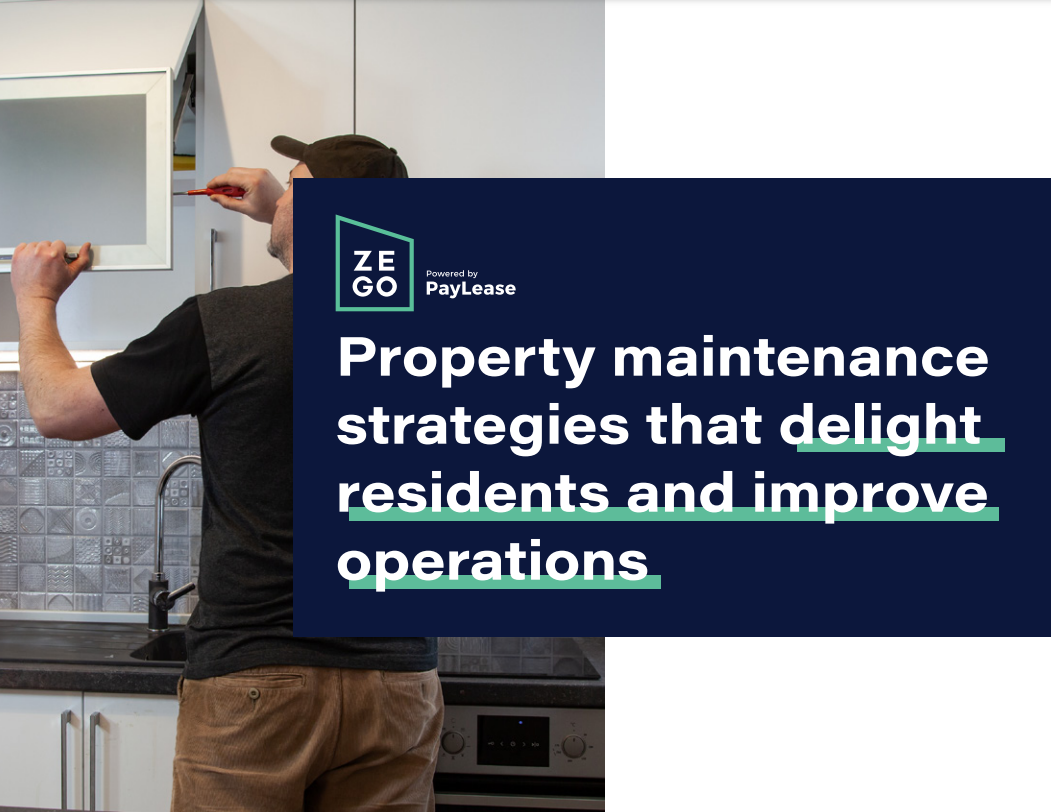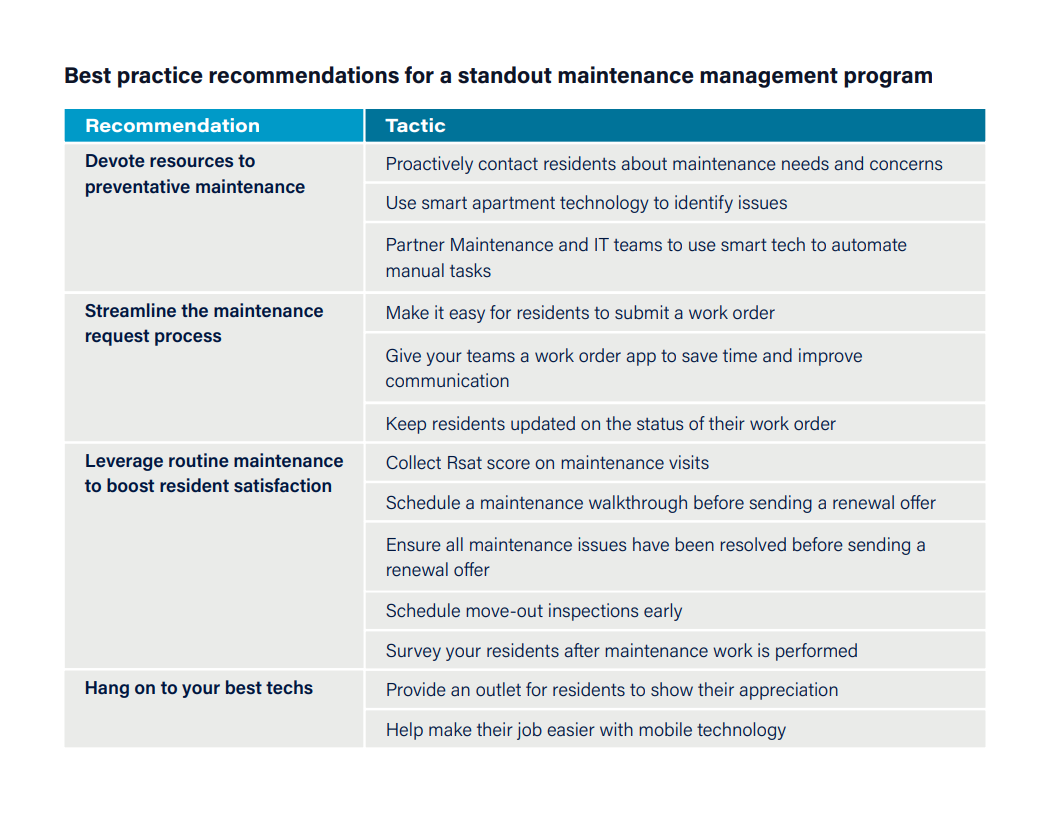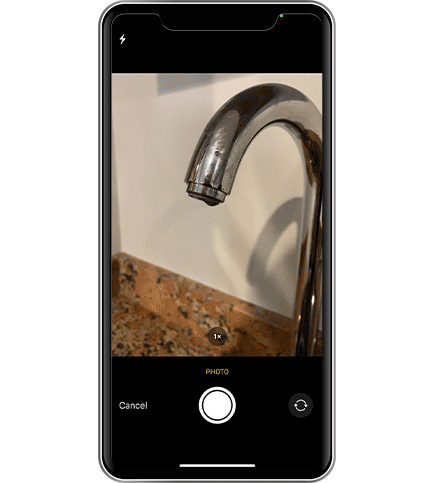4 Tips for managing tenant maintenance requests at multifamily communities
Learn actionable tips for managing tenant maintenance requests at multifamily communities, and vastly improve your resident experience.
Ask any renter what the biggest advantage to renting is and 9 times out of 10 their top answers will be “not having to manage the responsibility of owning a home.” Avoiding the responsibilities of maintenance and repair work of a home is a huge draw for renters. So when something breaks, residents expect their management company to address the issue – and quickly. Failing to adequately address maintenance erodes resident satisfaction and can ultimately cost you a resident.
According to an NMHC Apartment Residents Preferences report, 31% of residents cite “better apartment management” as a reason for moving to a different community. And that can be costly! Our own research shows it costs approximately $3,850 to replace a resident. Even if you replace that resident with one who pays $200 more, it will still take 19 months to break even ($3850/$200 =19 months).
The tenant experience when making maintenance requests is one of the top three drivers of unit turnover at multifamily communities. But the good news is it’s entirely within management’s control. Surprisingly, only 16% of property managers identify “property improvements” as a top goal, according to NARPM. But with an average price tag of $3,850 to turn a unit, management companies can’t afford to lose residents to factors that are within their control.
FREE DOWNLOAD Get your free copy of our eBook and learn how to improve the maintenance process to increase resident satisfaction.


Improve the maintenance process with strategies that delight residents
Improving the tenant maintenance request experience is in the best interest of the property managers
It’s in the best interest of the multifamily operators to have a smooth property maintenance process. If submitting a tenant maintenance request is cumbersome, residents may fail to report issues that aren’t disrupting their lives. For instance, they might have a leaky faucet or a dishwasher that makes an irritating sound. But rather than addressing those issues when they are minor, residents may wait until the issue requires a much larger, more expensive repair.
The “small” things that are inconvenient to report wear on residents’ nerves and drive them to seek out nicer communities. And a bumpy maintenance process, even for only one resident, can come back to haunt property managers. Because when that resident moves out, they will likely share their negative experience online. In fact, Rent.com studied the most common topics of resident reviews. Not only was maintenance one of the top topics, but the majority of reviews that mentioned maintenance were negative. Negative reviews can hurt your occupancy rates, as 72% of residents reference apartment ratings and reviews when searching for their next apartment.
Anything you can do to keep your residents satisfied is in your best interest. And that includes mastering the maintenance process. Here are four ways you can start doing that today.
4 tips for managing tenant maintenance requests at multifamily communities:
1. Devote resources to preventative maintenance
Maintenance emergencies are inevitable. Especially with older properties. But the more resources you can allocate to preventative maintenance, the better. Throw the old “if it ain’t broke don’t fix it” idiom in the trash. Ideally, if you can stop things from breaking before they actually break, the savings will be exponential.
NAA recently interviewed Scott Moore, CIO of Cortland, on their portfolio-wide installation of operating sensors on mechanical equipment to help isolate potential issues. “The goal and the vision is to know that an AC unit has been running for 12 hours, but it hasn’t changed the temperature in the unit… that would indicate that it’s going to fail in the middle of summer, and we can replace it proactively. That’s obviously going to be a much better experience for our residents,” said Moore. Managing operating expenses is also much easier with that level of visibility and less “out-of-the-blue” emergency maintenance costs.
- Contact residents about their maintenance needs and concerns: Catching issues before they reach a breaking point is especially important. Not only for your building but for resident satisfaction. Checking in with residents to make sure everything is functioning properly sends a message that you value their comfort and want them to be satisfied with their home. Plus, you may be able to resolve minor issues before they turn into something bigger (or more expensive to fix).
- Use smart technology to identify issues: Smart apartment technology alerts staff to potential problems in your communities, helping you avoid costly disasters linked to utilities. IoT technology and sensors can detect things like leaks, mold, or malfunctioning HVAC systems, which usually result in excessive utility usage.
For instance, let’s say a faucet springs a leak in one of your units. It could possibly take weeks for your resident to notice, causing water usage to spike, or worse, cause water damage. If you had water sensors installed on the building’s plumbing system, the leak would be identified in a matter of hours, not weeks, and the problem could be fixed before it became a bigger issue.
- Partner Maintenance and IT Teams to automate manual tasks: The global smart apartment market is expected to grow from $1.67 billion in 2020 to $1.87 billion in 2021. And it’s expected to reach $2.68 billion in 2025. That means maintenance technicians are going to have to become more familiar with programming and troubleshooting smart devices as they are progressively implemented into multifamily communities.
“They not only need to have experience with all the new technologies like smart locks, lighting systems, and thermostats but also with all the other devices that use control boards and networks to operate and communicate,” says Paul DeFruscio, Vice President, Asset at AVE by Korman Communities. “It’s just becoming the new normal. The maintenance team is increasingly partnering with the IT team.”
2. Streamline the process of submitting maintenance requests for tenants
Things have the potential to go south at the very beginning of the process when residents report an issue. If there’s not an easy way for them to submit tenant maintenance requests, that can cause frustration. Plus, it can prevent your maintenance team from getting accurate details about the issue so they arrive unprepared for the visit.
- Make it easy for tenants to submit maintenance requests: NMHC’s data shows that 64% of renters think the most convenient way to report an issue is by using a tenant maintenance app. Digital and in-app maintenance requests are continuing to gain traction because of their convenience and efficiency. Residents used to walk into the leasing office, and tell the agent, “my drain is backed up.” The agent would write a ticket for the maintenance tech who would follow up with a tree of questioning – which drain? Which sink? The one with the disposal?
With a tenant management app, the maintenance tech can ask subsequent questions before they enter the unit. The resident can also provide details and attach pictures. Now maintenance can actually see the problem before they enter the unit. And they can properly prepare ahead of time
Residents at Edison47 properties love that they can easily fire off a tenant maintenance request and receive excellent customer service directly from their phones. Jered Lerum, Director of Business Development for Edison47, said their staff love this improved work order management process too. “For the site staff to be able to actively engage in conversation from a maintenance standpoint – clarifying questions, seeing photos of the issue… it just streamlines the process, it makes maintenance more efficient, all with the goal of making for happier sites and happier residents.”
- Keep residents updated on the status of their maintenance work order: Residents don’t want to be in the dark about the status of their repair. It’s important they have an avenue to check the status. Think of Uber Eats. Customers see real-time updates about their order and have an estimated time of arrival. Residents appreciate the same transparency when it comes to work happening in their unit.“Today’s residents live their lives through their phones, and they spend much of that time in mobile apps. We should be striving to meet them there… Meeting them there is not sending emails. That’s a completely different medium than truly communicating through push notifications right through your phone. If we can meet them where they’re living digitally, we want to be there.” – Connor Duffy, Customer Experience Manager at Beacon Communities.
- Give your teams a tenant maintenance app to save time and improve communication: With a tenant maintenance app, tracking software takes the stress out of incomplete apartment maintenance requests, enabling your staff to manage requests across multiple properties and improve the overall experience for your multifamily community.
3. Conduct routine maintenance throughout the resident lifecycle to boost satisfaction
Conducting routine maintenance inspections can minimize potential problems that impact resident satisfaction. Most management companies require a move-out inspection, but there are other specific points throughout the resident lifecycle that you can easily check-in and ensure residents are happy with the maintenance process and property condition.
- Collect an Rsat score on maintenance visits: After a work order is completed, send out a quick one-question automated survey to determine their Resident Satisfaction Score (Rsat). This can be done by having each resident rate their experience on a scale of 1-5. Over time, you will be able to track if the average score goes up or down so you can identify any trends about what’s making them happy or unsatisfied with the process.
- Survey your residents after a tenant maintenance request is completed: Asking residents for feedback lets them know that you value their experience and opinions. Just because a maintenance request has been closed out doesn’t mean a resident is happy with the outcome. By following up with a quick survey after the work is complete you can ensure residents are satisfied and address any concerns immediately. Some maintenance apps even allow you to automate this process by triggering a survey to send after a maintenance request has been closed. Here are some sample maintenance survey questions:
-
-
- What maintenance service did you receive?
- How satisfied were you with the maintenance request process?
- Rate how satisfied were you with the length of time it took to complete your request?
- How satisfied were you with the maintenance team?
- Rate how satisfied were you with the cleanliness of the work done in your home
- Any additional comments or suggestions about the maintenance repair process?
-
- Schedule a maintenance walkthrough before sending a renewal offer: Chances are, if your residents have things in their unit that could use some attention, they won’t be too keen to renew. Prior to initiating a conversation about their renewal, it’s a good idea to inspect their unit and identify items that aren’t working properly and arrange for them to be taken care of.
- Ensure all maintenance issues have been resolved before sending a renewal offer: If you conduct a walkthrough before renewal time, it’s extremely important to follow through on the promises you made at that time. Residents will be hesitant to renew if there are unkept promises about improvements to their homes.
4. Hang on to your best property maintenance techs
With the industry’s high rate of maintenance team turnover, many companies are forced to spend valuable time training new techs instead of focusing on portfolio growth. So how can you retain good talent? Show your appreciation for them, and let residents praise their work so they know they are a valued member of your team. Also, implement technology solutions like a tenant maintenance app that makes their job easier.
- Provide an outlet for residents to show their appreciation: Apartment maintenance can be a demanding, yet thankless job. A little appreciation can go a long way in terms of reducing turnover. We talked to John Reardon, VP of Marketing at Beacon Communities who said, “before Zego Mobile Doorman, work orders would go into the property management system, and it all kind of happened behind the curtain. The resident would go home, their stuff is fixed, and the maintenance person never really gets a thank you,” Reardon said. “Now, because it’s so incredibly easy for residents to reach out, we’ve started seeing residents actually writing, ‘Thanks, this is great!’ Just a simple thing like that. When we share that with the maintenance teams, it’s actually a pretty good engagement driver. It helps fill their tanks back up and really motivates them when they see that people do actually appreciate their work.”
After rolling out a mobile maintenance management system, Joanna Zabriskie, President of BH Management, was pleased with the positive reaction she received. “What’s really been interesting to see was the whole-hearted adoption of this platform by our maintenance teams,” Zabriskie says. “I’ll go out to a site and they’ll show me their phone and say, ‘Look at the stars I got from this resident for doing their work order.’ They love it.”
 Help make their job easier with a mobile tenant maintenance request app: Besides wanting higher pay, being unhappy in their current organization is the second highest reason people quit their jobs. Showing an interest in how efficiently your maintenance team operates could help attract and retain better talent. Being a maintenance technician for an apartment community is a tough job. If your maintenance process is set up so that the details of each ticket are easily accessible on their mobile device, that can make the job less daunting. Because they don’t have to run back and forth to get parts, check the next ticket, etc. With technology saving them time and energy, they’ll be less likely to leave and switch to a community that’s still operating manually.
Help make their job easier with a mobile tenant maintenance request app: Besides wanting higher pay, being unhappy in their current organization is the second highest reason people quit their jobs. Showing an interest in how efficiently your maintenance team operates could help attract and retain better talent. Being a maintenance technician for an apartment community is a tough job. If your maintenance process is set up so that the details of each ticket are easily accessible on their mobile device, that can make the job less daunting. Because they don’t have to run back and forth to get parts, check the next ticket, etc. With technology saving them time and energy, they’ll be less likely to leave and switch to a community that’s still operating manually.
In summary, maintenance repairs are inevitable, no matter the age of your property or portfolio type. And how your team manages and resolves service requests profoundly impacts resident happiness. To learn more about how Zego can help improve tenant maintenance requests at your property schedule time to speak with a Zego Rep.
Create the best community app for your residents
Get a custom quote for your all-in-one community app to help on-site teams go above and beyond for residents.